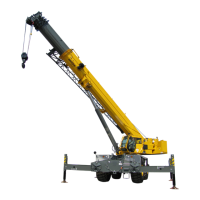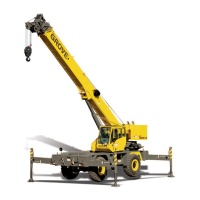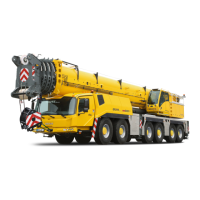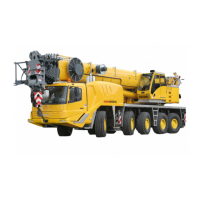Grove Published 04-04-2017, Control # 446-09 2-21
RT770E OPERATOR MANUAL SAFETY INFORMATION
Counterweight
On cranes equipped with removable counterweights, ensure
the appropriate counterweight sections are properly installed
for the lift being considered.
Do not add material to the counterweight to increase
capacity. United States Federal law prohibits modification or
additions which affect the capacity or safe operation of the
equipment without the manufacturer’s written approval.
[29CFR 1926.1434]
Outrigger Lift Off
Regarding “lifting” of an outrigger pad during craning
activities, be advised that the rated loads for these cranes,
as indicated on the crane’s Load Chart, do not exceed 85%
of the tipping load on outriggers as determined by SAE J765
OCT90 “Cranes Stability Test Code.” An outrigger pad may
lift off the ground during operation of the crane within the
capacity limits of the Load Chart, yet the crane will not have
reached instability. The “balance point” for stability testing
according to SAE and Manitowoc criteria is a condition of
loading wherein the load moment acting to overturn the
crane is equal to the maximum moment of the crane
available to resist overturning. This balance point or point of
instability for a crane does not depend on “lifting” of an
outrigger but rather on comparison of the “opposing” load
moments.
The occurrence of an outrigger lifting from the ground is often
attributed to the natural flex in the crane’s frame. This may
happen when lifting a load in certain configurations within the
capacity limits of the Load Chart and is not necessarily an
indication of an unstable condition.
Provided the crane is properly set up, the crane is in good
working condition, that all operator’s aids are properly
programmed, that the qualified crane operator adheres to
the instructions found in the applicable Load Chart, Operator
Manual and decals on the crane, the crane should not be
unstable.
Multiple Crane Lifts
Multiple crane lifts are not recommended.
Any lift that requires more than one crane must be precisely
planned and coordinated by a designated person. If it is
necessary to perform a multi-crane lift, the operator shall be
responsible for assuring that the following minimum safety
precautions are taken:
• Secure the services of a designated person to direct the
operation.
• Use one qualified signal person.
• Coordinate lifting plans with the operators, designated
person, and signal person prior to beginning the lift.
• Maintain communication between all parties throughout
the entire operation. If possible, provide approved radio
equipment for voice communication between all parties
engaged in the lift.
• Use outriggers on cranes so equipped.
• Calculate the amount of weight to be lifted by each crane
and attach slings at the correct points for proper weight
distribution.
• Ensure the load lines are directly over the attach points
to avoid side loading and transfer of loading from one
crane to the other.
• Do not travel. Lift only from a stationary position.
Tilt-Up Panel Lifting
Requirements and recommendations regarding operation
and use of Grove Cranes are stated on decals and in the
Operator and Safety Handbook and other manuals provided
with each specific model machine. Using the subject crane to
perform tilt-up panel lifting with two hoist lines poses new and
different hazards than does normal lifting use.
Therefore, the following additional precautions must be
taken if it is necessary for the crane to be used to perform tilt-
up panel lifting using a crane equipped with two hoists:
• The crane must be set up and operated in accordance
with Grove’s instructions in the Operator and Safety
Handbook, Load Capacity Chart, and decals affixed to
the crane.
• The hoist rope from the main hoist shall be reeved over
the main boom nose reeved for two parts of line.
• The hoist rope from the auxiliary hoist shall be reeved
over the auxiliary boom nose reeved for one part of line.
• The load shall be connected with the main hoist line
connected to the end closest to crane and the auxiliary
hoist line connected to the end farthest from the crane.
• The anti-two block system shall be installed and
inspected to confirm that it is active to monitor both hoist
lines.
• The RCL hoist selection shall be set to main hoist and
two parts of line.
• The wire rope and sheaves shall be inspected prior to
and following the lifting operations for chaffing or
scrubbing.
• The total gross load shall not exceed 80% of the
standard load chart. The operator shall be responsible to
control this as the RCL does not have a feature to set
reduced lifting limits.
• The auxiliary hoist line shall be considered part of the
deducts to determine net allowable load.
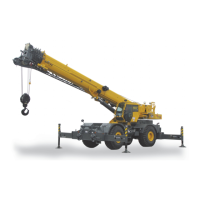
